Publications
Need to be tax-exempt?
Contact Laura Tharnish before ordering.
ltharnish2@unl.edu or 402-472-1576
-
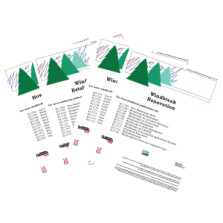
The Basics of Windbreaks
$0.00Windbreaks reduce wind speed and create sheltered zones for growing crops and raising livestock. Windbreaks also protect living and working areas, and provide critical wildlife habitat in a landscape dominated by agricultural crops. This set of four Extension Circulars covers the basics of how windbreaks work, and how to set up, manage and renovate windbreaks.
How Windbreaks Work (EC1763) explains how windbreak structure -- height, density, number of rows, species composition, length, orientation and continuity -- determines how effective the windbreak will be in reducing wind speed and altering microclimate.
Windbreak Establishment (EC1764) contains information on how to plan and establish a windbreak uniquely suited to a particular site, including site preparation, plant material selection, weed control and replanting.
Windbreak Management (EC1768) details how to maintain the health and vigor of a windbreak throughout its life cycle. To-dos include weed control, protection from large animals and rodents, corrective pruning, insect and disease control and property chemical use.
Windbreak Renovation (EC1777) is a step-by-step guide to renovating older or neglected windbreaks to make them functional and effective again. Steps include identifying the primary purpose of the windbreak, evaluating the current condition of the windbreak and implementing suitable renovation techniques.
Format: Two four-page and two six-page Extension Circulars
Learn More -
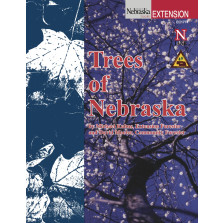
Trees of Nebraska
$1.00Tree planting and care have been important to Nebraskans since the days of J. Sterling Morton, who founded Arbor Day. This 76-page guide includes descriptions and detailed illustrations of identifying characteristics of 97 tree species commonly found in Nebraska. It also includes photos of a number of trees and a dichotomous key to help people identify tree species by comparing leaves, twigs, fruit, bark, and other tree parts.
Co-published with the Nebraska Forest Service.
Learn More -
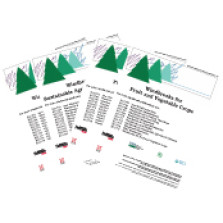
Windbreaks and the Environment
$0.00Windbreaks reduce wind speed and create sheltered zones for growing crops and raising livestock. Windbreaks also protect living and working areas, and provide critical wildlife habitat in a landscape dominated by agricultural crops. This set of four Extension Circulars explains how to plant windbreaks to improve the local environment for wildlife, field crops, and fruit and vegetable crops.
Windbreaks and Wildlife (EC1771) provides an overview of how windbreaks can benefit wildlife and what trees, shrubs, and planting designs to consider for various wildlife habitats.
Windbreaks in Sustainable Agricultural Systems (EC1772) contains information on field, livestock, and farmstead windbreaks and how to integrate these with agroforestry practices to create sustainable agricultural systems that enhance the local environment and add profitability.
Field Windbreaks (EC1778) explains how field windbreaks can increase crop yields while reducing inputs and improving both environmental quality and production efficiency.
Windbreaks for Fruit and Vegetable Crops (EC1779) contains information on how wind affects vegetable and fruit crops and how to use windbreaks to improve growing conditions, yield, and quality of fruit and vegetable crops.
Format: One eight-page, one four-page, and two six-page Extension Circulars
Learn More -
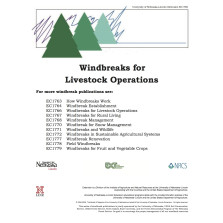
Windbreaks for Livestock Operations
$0.00Windbreaks plan an important role in the protection of livestock, particularly in young animals and in areas with cold northerly winds during the winter and early spring. Properly designed and placed windbreaks can provide benefits to feedlots, liestock pastures, and calving areas. A well-thought-out and properly cared for windbreak protects livestock in both winter and summer.
Time spent on layout, site preparation, weed control, and replanting is paid back many times throughout the life of a windbreak. Topics covered in this guide include:
- Research-based information on how windbreaks benefit livestock, including cattle, swine, and sheep. Covers winter protection, summer protection, snow control, increased yields, working environment, screening unsightly areas, and wildlife habitat
- Designing Your Windbreak
- The Multi-Row Windbreak Design
- The Twin-Row, High-Density Design
-
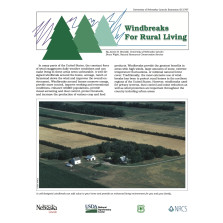
Windbreaks for Rural Living
$0.00A well-designed windbreak around the home, acreage, ranch, or farmstead slows the wind and improves the overall environment. Windbreaks around homes conserve energy, provide snow control, improve working and recreational conditions, enhance wildlife populations, provide visual screening and dust control, protect livestock, and increase the productionof various crop and food products. Windbreaks provide the greatest benefits in areas with high winds, large amounts of snow, extreme temperature fluctuations, or minimal natural forest cover.
This six-page guide describes how to design a windbreak around a home, ranch, or farmstead to slow the wind, conserve energy, provide snow and dust control and improve working and recreation environments. It includes illustrations of sample windbreak layouts on a farmstead and considerations for design.
Learn More